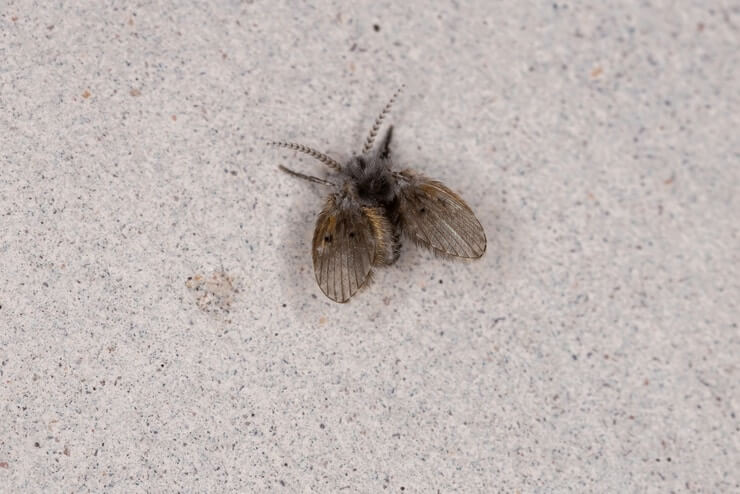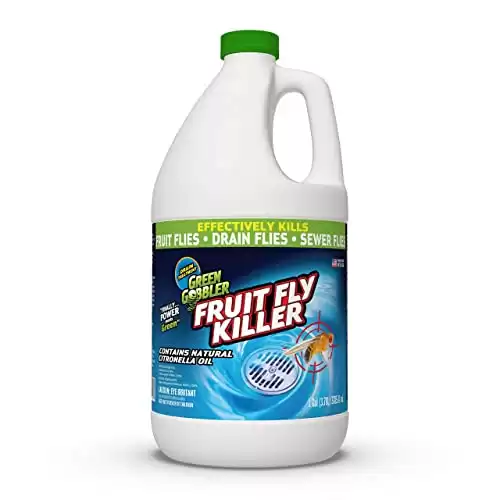Noticed tiny, gray flies swarming around your bathroom drains?
These are likely drain flies, and they’re more of a nuisance than a health hazard.
However, if left unattended, drain flies can multiply rapidly, creating a larger and more persistent problem.
Learn how to get rid of drain flies quickly and effectively, preventing future infestations and ensuring a clean and hygienic bathroom environment.

What Should You Know About Drain Flies?
Drain flies are tiny gray or brown colored flies that have short and wide wings.
They don’t really fly so much as they hop and jump from place to place.
Their short rounded wings limit their flying capacity, but they can easily jump out of reach and scurry off with a bouncing movement.
The most common type of drain fly in bathrooms is the moth fly.
With their small and lightweight bodies, drain flies can easily maneuver themselves out of harm’s way, and they can easily crawl into tight spaces like drains and pipes.
Drain flies measure less than a quarter of an inch in size, and most are smaller than a grain of rice.
Where Do Drain Flies Come From?
The sludge in pipes and poorly functioning drains are ideal for drain flies to breed in and lay eggs that will hatch into black worms.
This is why they crawl along bathroom pipes and down drains.
You may find drain fly larvae or black worms in your toilet bowl.
Drain flies love to lay eggs in toilet drains, under the bowl rim, and even under your toilet seat.
Drain flies may not be coming from your drain if you have open windows.
With their small size, drain flies can even crawl through a window screen.
Having a compost heap is an ideal place for a drain fly colony to nest, and your bathroom is merely the next nesting place.
Pour 1 cup of the solution down the drain pipe when your bathroom is least used. Results on the next day.
- Eliminates drain flies, fruit flies, nests, and eggs inside pipe drains
- Safe for pipes and septic systems
If you’re wondering “how long do drain flies live,” the answer is two weeks, but before you celebrate … remember, they are prolific breeders.
While you may find dead drain flies in bathroom areas, they have already ensured future generations will haunt you.
Each female drain fly can lay from 30 to 100 eggs, and each egg hatches within two days.
The drain fly larvae can mature through the pupae stage to become fully grown drain flies within as little as 20 days.
While drain flies are not renowned for being disease carriers, they do crawl through sludgy drains, and the potential for carrying disease and bacteria is always present.
Getting rid of a drain fly infestation is about more than just removing the flies; it is also ensuring there are no future generations of drain flies and checking that your bathroom pipes and drains are clean and not a health risk.
Essentially, drain flies in your bathroom are a symptom of having sludgy drains and poorly functioning plumbing.
Why Are There Drain Flies in My Bathroom?
You may wonder what attracts drain flies to your bathroom, and the answer is simple: organic matter and a moist or damp environment.
If your bathroom is damp, has leaking taps, or poorly functioning drains, you are creating the ideal environment for drain flies.
They will be attracted to come feed on mold, soap scum build-up, over-full bathroom wastebaskets, bathroom plants, damp or rotting bathroom carpeting, and stale bathroom towels that aren’t washed regularly.
Your bathroom and specifically your shower pan, bathtub, or drains are where these tenacious bugs can access water and organic material like mold.
Mold thrives on soap scum and limescale that collects around the shower drain, attracting drain flies.
Leaky showerheads create an ideal environment and that’s why there may be drain flies in showers.
Drain flies also love nesting in the damp and sludgy environment your bathroom creates.
If you have drains or pipes that are filled with gelatinous sludge, then drain flies will lay their eggs there, presenting future generations of drain flies that feed, breed, and proliferate throughout your bathroom.
How Do Drain Flies Get Into the Bathroom?
Drain flies coming from toilet bowls may be a sign there are drain fly larvae or black worms in your toilet drain.
They easily swim up the drain trap, drawn towards the oxygen in your bathroom.
You may wonder why there are drain flies in your bathroom when you have been cleaning your pipes and drains regularly.
Drain flies not coming from drains indicates you have an external nest where the drain flies originate.
While this may mean your plumbing is in fairly good condition, you have a potentially damaging situation if these drain flies start to lay their eggs in your bathroom plants, under your bathroom cabinets, and in your drains.
If you’re wondering how to find out where drain flies are coming from, simply tape your shower drains shut at night, and do this for a few nights.
If you find drain flies attached to the sticky side of the tape in the morning, then they are crawling up your drain.
Close the bathroom windows for a few days and check if there are no drain flies then.
If closing windows helps, then you need to start looking outside, checking your garden for areas with stagnant water, gutters that may be blocked, or damp spots under your home if you have a basement.
Even your bathroom ceiling can be a potential area for infestation, so check your light fittings too as damp from regular showering can introduce moisture to your insulation and ceiling fittings, attracting drain flies.
How to Get Rid of Drain Flies in Your Bathroom in Four Steps
While you can try several home remedies to get rid of bathroom drain flies, you can also turn to some chemicals that will help you make your bathroom, drains, and pipes less inviting.
Let’s consider the approach:
Step One: Trap Them
Spraying drain flies with commercial poison aerosols may not work as efficiently as simply trapping them.
Instead, mix equal parts of sugar, water, and apple cider vinegar in a jar or small bucket.
Also, add in three to five drops of dishwashing liquid.
The sugar and vinegar will attract the drain flies, while the soap will keep them trapped in the water where they will drown.
Leave the trap out for a few days or up to a week.
Then empty the trap far away from your home or add in an insecticide that will kill any drain flies that are still alive on the surface.
Repeat if necessary.
Alternatively, you can use UV-light traps developed specifically for flying insects, although the best performing ones might cost you extra.
However, if you also have gnats or mosquitoes in your house, these will pay off.
Step Two: Deal With the Larvae
Remember that while you may have killed off the drain flies bouncing around your bathtub, you will need to deal with the eggs, larvae, and pupae that are still in your drains.
This means doing more than just pouring ammonia down the drain.
Start by running the hot water tap in the bath, sink, and shower for several minutes to loosen sludge buildup.
Then pour a cup of white vinegar and baking soda into each drain, allow it several minutes to work before rinsing with hot water for at least five minutes again.
Your toilet drain may require a little more effort, and you need to close the water supply valve, letting the toilet flush completely.
Then use white vinegar and baking soda to clean your toilet drain, and when you’ve added several buckets of hot water down the toilet, you can refill the toilet tank as normal by opening the shutoff valve.
Step Three: Repeat With Commercial Cleaner
If the above procedures haven’t cleaned all the drain flies and their eggs or larvae, then you need to use an enzyme-based commercial cleaner to help you strip off the sludge layer in your drain pipes so you can effectively flush away the infestation.
Step Four: Get a Plumbing Professional
In older homes, you may find the drain pipe has perished over time and due to the buildup of sludge.
The drain may no longer be a contained environment, and your outside drains may be vulnerable to tree roots growing through the pipes, which will create hiding spaces for drain fly nests.
If this is the case, you will need to consult with a drain and plumbing expert to put a camera down the drain to assess the damage.
It may be necessary to replace your drain pipes and reseal the system to prevent drain flies from reinfesting the drain.
Repairs can be costly, so act quickly when you notice drain flies in your bathroom or black worms in your toilet bowl.
The longer you leave it, the more likely drain flies and the rot they thrive in will cause severe damage to your home’s plumbing.
How to Prevent Drain Flies From Coming Back to My Bathroom
Once you have removed the drain flies and their eggs from your bathroom, shower, and drains, you will find it’s a simple matter to ensure they don’t return.
Make sure your bathroom is a dry and sanitary environment.
Fix leaking taps, ensure drains are cleaned with white vinegar and hot water once a week to prevent sludge forming, and check your yard for damp breeding places where an outside drain fly nest may form.
Top Tip
Get into the habit of cleaning out drains and pipes once a week with a home remedy such as vinegar and hot water. Or be sure to run hot water down your pipes and drains before using a commercial drain and pipe cleaner.
Prevent your bathroom from becoming damp and moldy in winter by installing a dehumidifier or extractor fan.
Open bathroom windows after a shower, or use your HVAC system to maintain a dry environment.
Wash bathroom rugs regularly, and spray your shower doors, corners, and tile grout lines.
Simply mix a cup of water, half a cup of vinegar, and five drops of dishwashing liquid in a spray bottle and use daily to remove soap scum and limescale.
The Ultimate Guide to Bugs in the Bathroom
Concerned about the presence of bugs in your bathroom? Our expertly crafted guide takes a closer look at toilet bugs, providing you with essential information and actionable recommendations to address this common issue.


